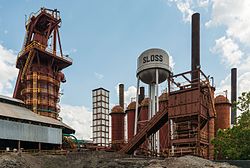Sloss Furnaces
|
Sloss Blast Furnace Site
|
|

Sloss Furnaces, Birmingham, in July 2016
|
|
| Location | 1st Ave. at 32nd St. Birmingham, Alabama |
|---|---|
| Coordinates | 33°31′14.36″N 86°47′28.70″W / 33.5206556°N 86.7913056°WCoordinates: 33°31′14.36″N 86°47′28.70″W / 33.5206556°N 86.7913056°W |
| Built | 1881 |
| Architect | James W. Sloss; Et al. |
| NRHP Reference # | 72000162 |
| Significant dates | |
| Added to NRHP | June 22, 1972 |
| Designated NHL | May 29, 1981 |
Sloss Furnaces is a National Historic Landmark in Birmingham, Alabama in the United States. It operated as a pig iron-producing blast furnace from 1882 to 1971. After closing it became one of the first industrial sites (and the only blast furnace) in the U.S. to be preserved and restored for public use. In 1981 the furnaces were designated a National Historic Landmark by the United States Department of the Interior.
The site currently serves as an interpretive museum of industry and hosts a nationally recognized metal arts program. It also serves as a concert and festival venue. Construction is also under way on a new $10 million visitors' center. The furnace site, along a wide strip of land reserved in Birmingham's original city plan for railroads and industry, is also part of a proposed linear park through downtown Birmingham. An annual Halloween haunted attraction called "Sloss Fright Furnace" is held at the site.
Colonel James Withers Sloss was one of the founders of Birmingham, helping to promote railroad development in Jones Valley, Alabama and participating in the Pratt Coke and Coal Company, one of the new city's first manufacturers. In 1880 he formed his own company, the Sloss Furnace Company, and began construction of Birmingham's first blast furnace on 50 acres (202,000 m²) of land donated by the Elyton Land Company for industrial development. The engineer in charge of construction was Harry Hargreaves, a former student of English inventor Thomas Whitwell. The two Whitwell-type furnaces were 60 feet (18 m) tall and 18 feet (5.4 m) in diameter. The first blast was initiated in April 1882. The facility produced 24,000 tons of high quality iron during its first year of operation. Sloss iron won a bronze medal at the Southern Exposition held in 1883 at Louisville, Kentucky.
In 1886 Sloss retired and sold the company to a group of investors who reorganized it in 1899 as the Sloss-Sheffield Steel and Iron Company. New blowers were installed in 1902, new boilers in 1906 and 1914 and the furnaces completely rebuilt with modern equipment between 1927 and 1931. In 1909 James Pickering Dovel had become the superintendent of construction. For the next 21 years, Sloss was Dovel's workshop for invention. He developed gas cleaning equipment, modified the design of the furnaces, and improved the linings of the furnaces. In all, some 17 patents are credited to Dovel. Sloss's No. 2 Furnace, rebuilt in 1927, included many of these inventions, earning Dovel and Sloss a national reputation for innovation. Through this aggressive campaign of modernization and expansion, including furnace and mining and quarrying operations all around Jefferson County, Sloss-Sheffield became the second largest seller of pig-iron in the district and among the largest in the world. During this period the company built 48 small cottages for black workers near the downtown furnace — a community that became known as "Sloss Quarters" or just "the quarters".
...
Wikipedia


